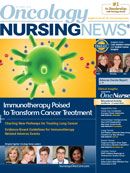Aldoxorubicin More Effective Than Doxorubicin in STS
Aldoxorubicin (formerly INNO-206) has demonstrated response rates that culminated in a higher incidence of stable disease when compared with doxorubicin as a first-line treatment for patients with advanced soft tissue sarcomas
Sant Chawla, MD
Aldoxorubicin (formerly INNO-206) has demonstrated response rates that culminated in a higher incidence of stable disease when compared with doxorubicin as a first-line treatment for patients with advanced soft tissue sarcomas, according to results from an ongoing phase IIb study.
In the study, patients treated with aldoxorubicin had an overall response rate of 22% compared with 0% in those treated with doxorubicin (P = .004). Additionally, 50% of those treated with doxorubicin had progressive disease compared with 32% of patients treated with aldoxorubicin.
The interim results from the study were released at the 18th Annual Connective Tissue Oncology Society (CTOS) Meeting held October 30-November 2, 2013 in New York City. (Poster 102).
Aldoxorubicin is a combination of doxorubicin and a novel single-molecule linker that quickly binds directly to endogenous circulating albumin through the EMCH linker. Protein-hungry tumors concentrate albumin, which increases the delivery of the linker molecule (with attached doxorubicin) to tumor sites. Doxorubicin is then released into the acidic environment of the tumor, leaving the neutral environment of healthy tissues unaffected. This proposed mechanism of action allows for greater doses of doxorubicin to be administered in a greater number of drug cycles while reducing toxic side effects.
In this phase IIb trial, 123 patients aged 18-80 years with metastatic, locally advanced, or unresectable soft tissue sarcomas were randomized 2:1 to receive 350 mg/m2 aldoxorubicin (260 mg/m2 doxorubicin equivalents) intravenously or 75 mg/m2 doxorubicin intravenously every 3 weeks for up to 6 cycles. The data presented at the CTOS meeting involved the 47 patients who remain active in the study (aldoxorubicin: n = 36; doxorubicin: n= 11).
The findings indicated that aldoxorubicin can be safely administered at doses exceeding three-and-a-half times the standard dosing of doxorubicin.
A higher percentage of patients treated with aldoxorubicin completed both 4 cycles and 6 cycles of treatment compared with those receiving doxorubicin. There was no significant reduction in cardiac function reported in the aldoxorubicin population.
Twenty-four serious adverse events (SAEs) were associated with aldoxorubicin versus six SAEs associated with doxorubicin. All SAEs were resolved, and treatment was not discontinued. One treatment-related death occurred in a patient treated with doxorubicin.
In a phase Ib/II trial, 76.9% (10 of13 patients) with relapsed or refractory soft tissue sarcoma saw clinical benefit with aldoxorubicin at the maximum tolerated dosage. Of the 13 evaluable patients, five achieved partial response, seven showed prolonged stable disease, and eight had tumor shrinkage. In the trial, median estimated progression-free survival was 6.4 months, which compares favorably with the historical median of approximately 3 months in this patient population.

Innovative Program Reduces Nurse Turnover and Fosters Development
Published: September 12th 2024 | Updated: September 12th 2024The US Oncology Network (The Network) has developed one of the most comprehensive programs in the nation to support the professional development and retention of new oncology nurses.


